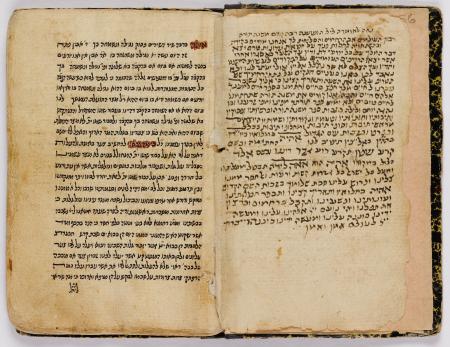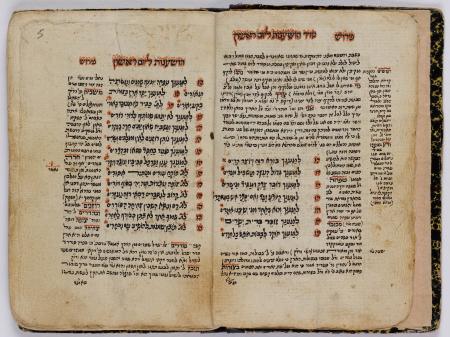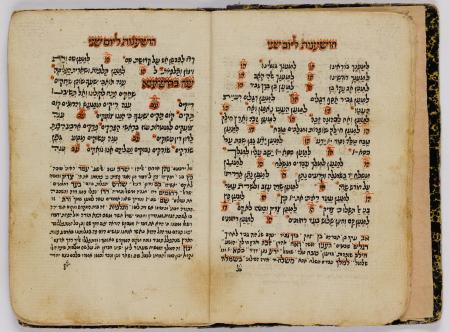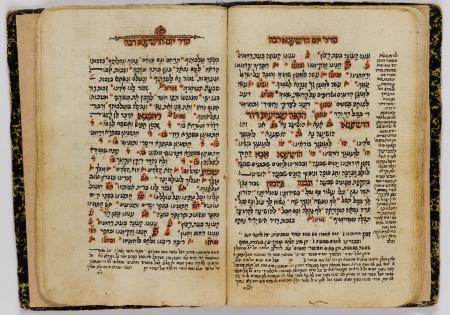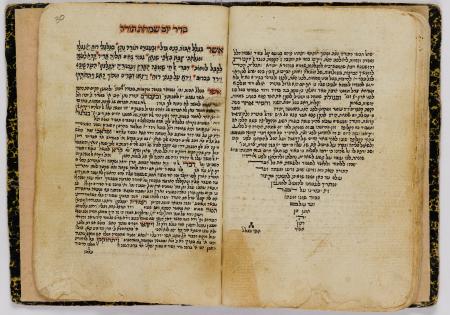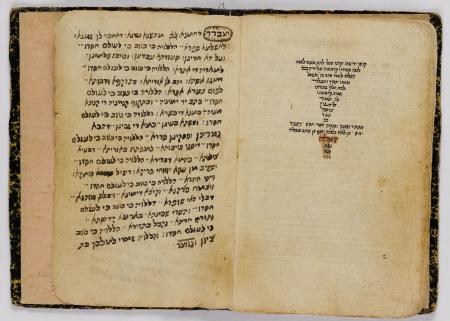Obj. ID: 53802
Hebrew Illuminated Manuscripts Hosha'anot le-Sukkot, Yemen, circa 1775
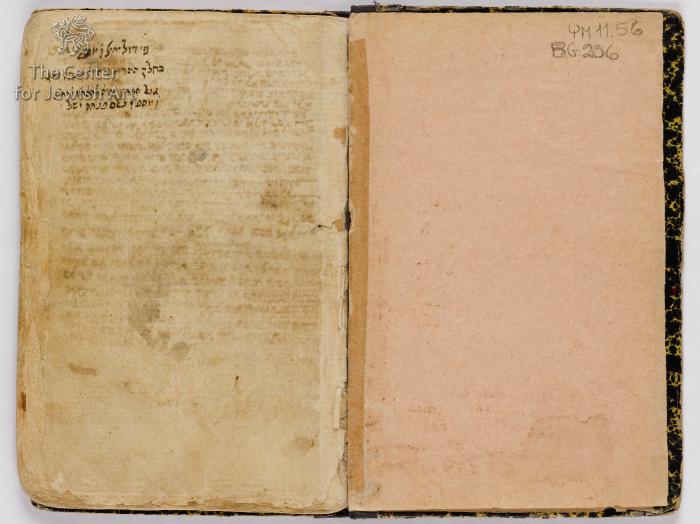
The following description was prepared by William Gross:
Prayers and Piyttim for Sukkot and Simchat Torah, along with the commentary "Etz Chaim" of Yichyeh Tzalach. There are listed three generations of owners, as well as the name of a donor. The manuscript was written and signed by Rabbi Yichyeh Tzalach. There is another manuscript in the Gross Family Collection from his hand, YM.011.100.
Rabbi Yiḥya Ṣāleḥ (alternative spellings: Yichyah Tzalach; Yehiya Saleh) and who is also known by the acronym of Maharitz (Heb. מהרי"ץ) = Moreinu HaRav Yichyah Tzalach (1713 – 1805), was no doubt the greatest exponent of Jewish law known to Yemen. He is to be remembered mostly for his ardent work for the preservation of Yemenite Jewish customs and traditions, which he articulated so well in his many writings. In this regard, he was strongly influenced by the Rabbis of his previous generation, Rabbi Yehudah Sa'adi and Rabbi Yihya al-Bashiri. Initially, Rabbi Yiḥya Ṣāleḥ worked as a blacksmith until the age of thirty, after which he worked as a scrivener of sacred texts (Heb. "sofer").
Yiḥya was born in the lunar month of Cheshvan, in the year 5474 anno mundi, a year corresponding to 1713 CE,[2] to Joseph b. Ṣāliḥ. Ṣāliḥ, his grandfather (d. 1749), was a survivor of the infamous Mawza Exile, and the founder of the Saleh synagogue in Sana'a, and one of the city's judges and ritual slaughterers (Heb. shochet).
Rabbi Yiḥya Ṣāleḥ was contemporary with Rabbi Chaim Joseph David Azulai, a great rabbinic teacher and scholar, with whom he exchanged responsum while the latter lived in Egypt. Rabbi Yiḥye Ṣāleḥ (henceforth: Maharitz) is the author of the Questions and Responsa, Pe'ūlath Ṣadīq and has also written a brief but comprehensive commentary on the Yemenite Baladi-rite Prayer Book, entitled ‘Eṣ Ḥayyim in which appears the responsum addressed to him from Rabbi Chaim Joseph David Azulai Maharitz also compiled a work on Bible orthography (Hebrew vowels and trope symbols used in biblical texts) known as Ḥeleq Hadiqdūq, among other writings.
Although Maharitz served as chief judge (Av Beit-Din) and President of the rabbinic court at Ṣanʻā’, for most of his life, he worked under the shadow of his co-religionist, Shalom Cohen al-Iraqi (al-Ousta), who had attained high acclaim and eminence by virtue of his role as comptroller of the customs and of the royal buildings and gardens; one of the most honorable offices in the king's court at Sana'a.
This is the handwriting of Rabbi Yichya son of R' Yosef Tzalach, the greatest Yemen sage of those times. In his youth, he earned a living by copying holy books, a prevalent practice among Yemenite sages. Rabbi Yichya son of R' Yosef Tzalach – the Maharitz (1715-1805), was the foremost Yemenite rabbi in the 18th century and one of the leading later Torah authorities. Disciple of his grandfather Mari Tzalach and disciple of Rabbi Aharon HaCohen Araki, Rabbi Yichye Araki and Rabbi David Mashraki, author of Shtilei Zetim. At the age of 43, he was appointed Chief Rabbi and Ra'avad of all the Yemenite communities, a position he held for more than 45 years. His authority was unequivocally accepted in Yemen and until this day, many members of the Yemenite community follow his customs and rulings. He compiled the Tiklal siddur with the Etz Chaim commentary and many halachic works: Zevach Todah, Sha'arei Kedusha on the laws of shechita, Sha'arei Tahara on the laws of Nidah, Pe'ulat Tzaddik responsa and other books of halachic, mussar and Kabbalah.
Pages: 43



